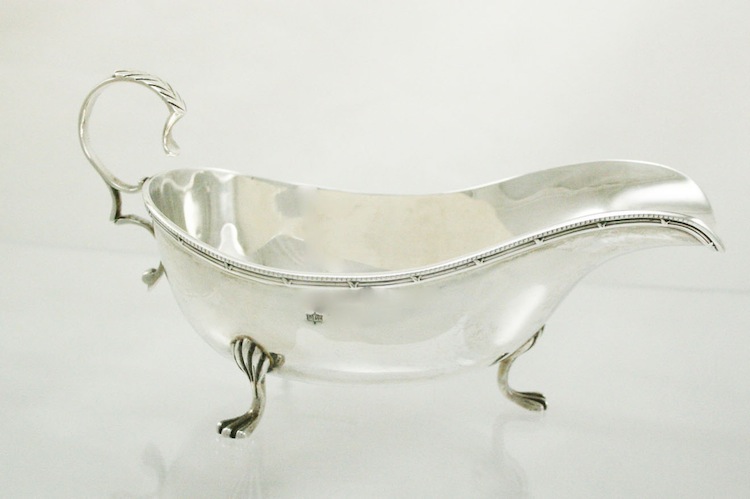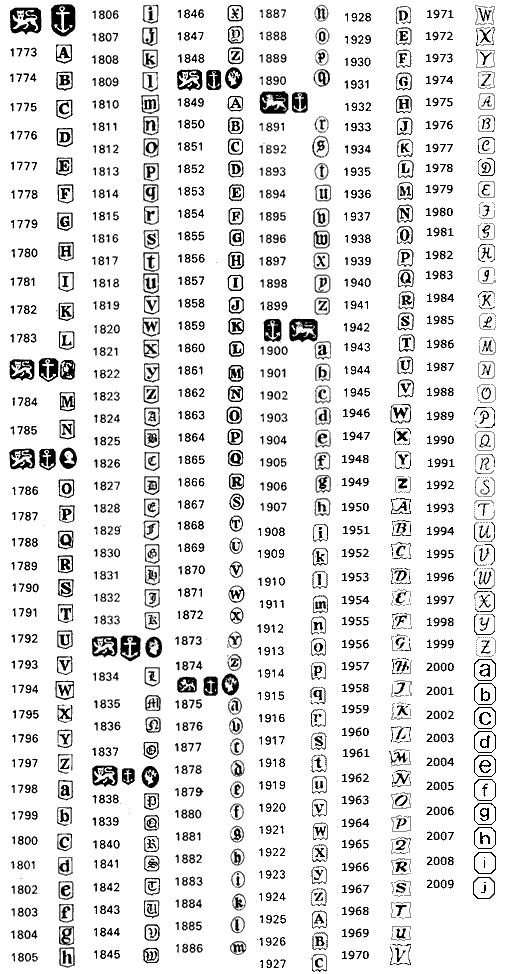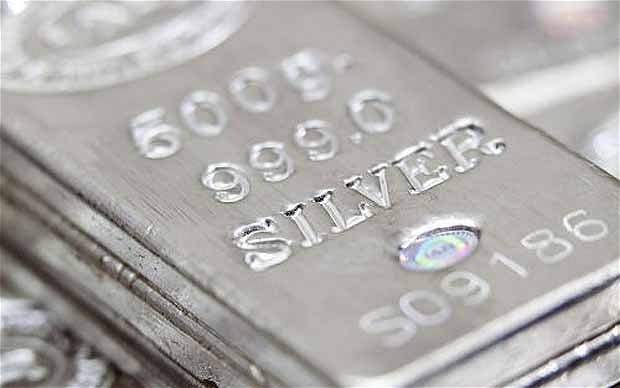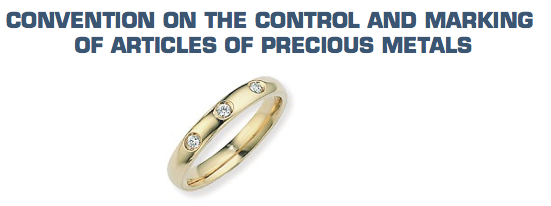BIRMINGHAM, England (1773 – Present)
Birmingham Assay Office
PO Box 151
Newhall St
Birmingham B3 1SB
Telephone 0121 236 6951
info@theassayoffice.co.uk
History and Hallmarks
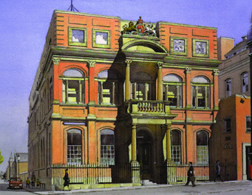 The history of hallmarking dates back to 1300 when a Statute of Edward I instituted the assaying (testing) and marking of precious metals. The original aim of the system remains unchanged; the protection of the public against fraud and of the trader against unfair competition. Indeed, hallmarking is one of the oldest forms of consumer protection.
The history of hallmarking dates back to 1300 when a Statute of Edward I instituted the assaying (testing) and marking of precious metals. The original aim of the system remains unchanged; the protection of the public against fraud and of the trader against unfair competition. Indeed, hallmarking is one of the oldest forms of consumer protection.
Hallmarking is as necessary today as it was in 1300 because when jewellery and silverware are manufactured, precious metals are not used in their pure form, as they are too soft. Gold, Silver, Platinum and Palladium are always alloyed with copper or other metals to create an alloy that is more suitable to the requirements of the jeweller. Such an alloy needs to be strong, workable, yet still attractive.
Owing to the high value of Gold, Platinum, Palladium and silver, there are significant profits to be gained by reducing the precious metal content of an alloy at the manufacturing stage. Base metal articles plated with a thin coat of gold or silver look like the same articles made wholly of precious metal, at least until the plating wears, and even an expert cannot determine the quality or standard of precious metal items by eye or touch alone.
The Statute of 1300 allowed the Wardens of the Company of Goldsmiths in London to go out to workshops in the City and assay silver and gold. However, only silver that met the required standard was marked at this time, with the symbol of the leopard’s head which is still the mark of the London Assay Office today. Gradually gold came to be marked in the same way as silver.
In 1363, the maker’s mark was added to the hallmark. To begin with, most of them were pictorial but as literacy rates rose, the system of using the maker’s initials was introduced.
Quite some time after, in 1478, the Wardens of Goldsmiths set themselves up in Goldsmiths Hall and paid a salaried assayer to test and mark items submitted to them. This led to the introduction of the date letter in order to make successive assayers accountable for their work.
Birmingham Assay Office was founded by an Act of Parliament in 1773. It had become clear by this time to the silversmiths of Birmingham, especially Matthew Boulton, that their trade would never truly prosper without an Office of their own. Boulton lobbied Parliament vigorously and was finally rewarded by the Hallmarking Act 1773, which founded the Birmingham Assay Office.
Hallmarking of precious metals is still a legal requirement in the UK and in 2006 Birmingham Assay Office is the largest Assay Office in the World, handling over 12 million articles per year.
Assay marking began in Birmingham in 1773. The date letter, which followed a 25 year cycle, was changed in July until 1975 when it (along with all other British date letter sequences) changed in January. The Britannia figure was used in silver of 95.84% purity.
Birmingham gained the right to assay gold and silver articles with the establishment of the Birmingham Assay Office in 1773. The Assay Office was established largely due to the efforts of Matthew Boulton.
There is a story that when the manufacturers of Birmingham and Sheffield (established at the same time) were in London lobbying Parliament for the institution of Assay Offices, they stayed at an inn in the Strand called the “Crown and Anchor”. Thinking that these two symbols would make good hallmarks, they decided to toss a coin to see which town would get which mark.
The Birmingham Assay Office was founded in 1773, when the city and some of its most famous entrepreneurs were playing a leading role in the Industrial Revolution.
At this time, silversmithing was booming in Birmingham, with manufacturers making buttons, buckles, spoons and other small articles. In 1762, Matthew Boulton made a major investment in his family business, relocating it from Snow Hill to the purpose built Soho Manufactory in Handsworth, then just outside the Birmingham boundary. The new factory employed over 700 people, but Boulton soon discovered that having to send all his items to Chester Assay Office for Hallmarking was a serious handicap to his business. Apart from the expense and delay, those articles which did survive the perils of travelling 70 miles each way in horse-drawn carriages, over rutted roads frequented by highwaymen, were sometimes damaged by careless packing, or copied by the Chester silversmiths. Boulton resolved to take action on behalf of all Birmingham silversmiths.
Boulton’s neighbour, Lord Dartmouth MP, proved to be a valuable ally. He advised Boulton to promote an Act of Parliament authorising an Assay Office in Birmingham. Boulton was also approached by the Sheffield Cutlers’ Company who were fighting to establish an office in their town, and he agreed to fight the cause for both parties. He had staunch support from many local nobility, landed gentry and members of the royal family who were all satisfied customers. Despite major opposition from the Goldsmiths’ Company in London, Boulton’s tenacity and skilful lobbying won through, and the Assay Bill was given Royal Assent on 28th May 1773.
During his long stay in London, Boulton stayed at the Crown & Anchor Tavern in the Strand, a popular haunt for politicians, where much of the business was transacted. Quite how the decision was made is unclear, but it was probably the toss of a coin which determined that Birmingham, in the heart of the country and miles from the sea, should adopt the Anchor as its hallmarking symbol, whilst Sheffield took the Crown (subsequently changed to the Rose). Brummies are eternally grateful that Boulton did not stay at the Slug & Lettuce – or worse!
Once the Act was passed suitable premises were found, three rooms above the King’s Head Inn on New St, and the office opened for the receipt of work one day a week – Tuesday. The first day of opening was 31st August 1773 and not surprisingly the first customer was Matthew Boulton.
The Act of Parliament stipulated that the Office should be controlled by a Board of
thirty-six Guardians of the Standard of Wrought Plate in Birmingham, of whom not more than nine nor less than six might be connected with the trade. This was a departure from the older established office and halls, administered by the Guilds. The new Birmingham Assay Office was created to be self-supporting with all its revenues coming from charges for assaying or marking. Rapid industrial expansion provided great potential in the early years; by 1815 the Office had moved to premises in Little Cannon Street, and in 1877 moved again to its current site in Newhall St, complete with all its Victorian splendour.


![]() TABLE OF BIRMINGHAM DATE LETTERS • 1773 – 2009
TABLE OF BIRMINGHAM DATE LETTERS • 1773 – 2009
The date letters below show the background shape for silver. The same letters were used for Gold, which has been marked in Birmingham since 1824, but the background is a square with cut corners. There may be some variations in backgrounds during the late 19th century, especially on watch cases.
City of Birmingham – 1801 by Joseph Taylor
Birmingham Assay Office – Date Letters 1773 to 2009
The date letters below show the background shape for silver. The same letters were used for Gold, which has been marked in Birmingham since 1824, but the background is a square with cut corners. There may be some variations in backgrounds during the late 19th century, especially on watch cases.
BIRMINGHAM MAKERS’ MARKS
| C & B | Cocks & Bettridge | MB | Matthew Boulton |
| E & Co Ld | Elkington & Co | MB IF | Matthew Boulton & John Fothergill |
| EM & Co | Elkington Mason & Co | ML | Matthew Linwood |
| ES | Edward Smith | NM | Nathaniel Mills |
| ET | Edward Thomasson | P & T | William Postan & George Tye |
| FC | Francis Clark | REA | Robinson, Edkins & Aston |
| GU | George Unite | SP | Samual Pemberton |
| GW | Gervase Wheeler | T & P | Joeseph taylor & John Perry |
| H & T | Hillard & Thomasson | TS | Thomas Shaw |
| IB | John Bettridge | TW | Thomas Willmore |
| IS | John Shaw | WF | William Fowke |
| IT | Joseph Taylor | Y & W | Yapp & Woodward |
| JW | Joseph Willmore | L & Co | John Lawrence & Co |

